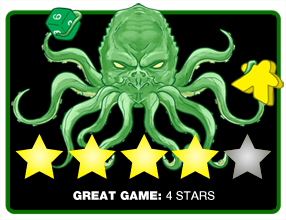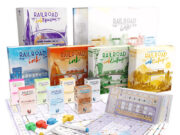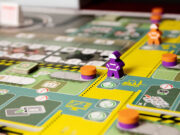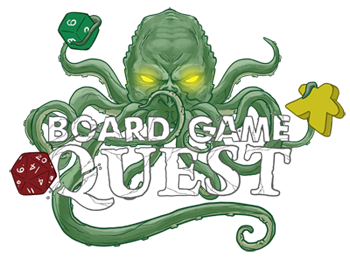 Games often borrow heavily from each other. The Deckbuilding in Dominion spawned a genre of games. But sometimes you want a little bit more. *In the distance some sing-song La-la-La’s float through the air*
Games often borrow heavily from each other. The Deckbuilding in Dominion spawned a genre of games. But sometimes you want a little bit more. *In the distance some sing-song La-la-La’s float through the air*
*Lost Ruins of Arnak and Dune Imperium enter the chat*
But sometimes you don’t want to battle monsters…
*Lost Ruins of Arnak exits the chat as the singing gets louder*
Or science fiction themes. Or maybe you don’t want to compete for victory with your friends *Dune Imperium exits the chat twice as the singing gets louder* and there just aren’t any games that do those things.
*Laa–Laa–La-La-La-Laa La-LaLaLa-Laa* Smurfs Hidden: Village arrives offering a family-friendly worker placement and deck-building game for one to five players ages 8 and up. Game times clock in closer to an hour than the 30 minutes listed on the box.
Gameplay Overview:
Each player gets a hand of starting Smurfs, each with their own unique power. The problem is these Starting Smurf powers aren’t great and some are quite bad. Players will alternate taking turns performing the following actions:
1. Play a Smurf card and use their ability
2. Place a Smurf worker on one of the locations to take its action. Some of these spaces require two Smurfs which means the first player that plays there won’t trigger the action or pay the associated cost. Some actions are dangerous which require rolling the danger die and if Azreal (the cat) is at that location you’ll also roll the orange cat die.

Some locations will grant resources that are used for the other location actions which include construction, sheltering Smurfs, Rescuing Smurfs from the forest or the Howlibird, or drawing new invention cards. Building inventions is a free action that can be done at any time.
Players can opt to play with a white danger die which has a few positive sides or a red one that’s all bad. The danger die will also move Azreal around, which can be good or bad, depending on your needs at that time. One of the icons on both die is the Howlibird which scoops up a Smurf worker and forces you to discard a card, with the bird preferring good cards over bad cards. You’ll get them back at the start of the next turn but losing a Smurf reduces the number of actions you can take in a round.
Once all the workers have been placed, they all return to the starting space and a Gargamel card is drawn which moves Azreal and then proceeds to do something bad. Within the bottom three cards is a Game Over card that ends the game.
Players get to draw a new hand of cards when their hand is empty. Play continues until you win by building all the Smurf homes, rescuing all of the Smurfs from the Dark Forest, and completing a number of Cake objectives (which are randomly selected tasks that include using all action spaces, building multiple houses in a round, etc.) before the Game Over card is revealed.

Game Experience:
It was Smurfy. Thank you for coming to my TED talk.
Predictable joke aside, this a fun worker placement and deckbuilding game. It’s also simpler than games like Lost Ruins of Arnak as your deck is just Smurfs and there are only three different resources to manage. Rescuing Smurfs makes your deck better, as both the shelter action and building Smurf homes with an addition by subtraction method of booting the lousy starting Smurfs out of your hand.
The Cake effort is the one that is generally accomplished while working on the other tasks but sometimes you need to delay tasks so you can build two houses or rescue two Smurfs in a round.

I was vague about the number of houses needing to be built, Smurfs needing rescuing, and cakes to be baked as those can be adjusted to make the game easier or more difficult (I tended to play on Care Bear which is a different 80’s IP but is what I call “easy mode”) but I like how the game’s difficulty can be adjusted to match what the players want.
Production wise, I absolutely love the wood resource tokens and workers while the cardboard-roofed Smurf Houses are neat and look great on the table. Unfortunately, the houses do create a little bit of an Everdell problem where the houses can block players’ views of different pieces of the board. On easy mode, there are empty house spaces that give your resource stash a place to sprawl out but in Smurfmare (love that name!) the board is quite cluttered as Smurfopolis and Cake cards cover the remaining available spaces.
There’s some randomness in the card draws that can be really impactful. For example, one of the Gargamel cards cuts your stashed wood in half. If you were saving up to build a house and then lost 2-3 wood, you’d feel that it could take multiple Smurfs the next round to build your stash back up. Meanwhile, if you completed that same house and had no wood to lose, then you dodged that bullet. Some other cards basically inhibit your ability to gain resources for that round, but you get them eventually.

That variability is also present in the Smurf deck. The relatively large collection of better Smurfs does add variability to each play, as does the order in which they turn up. Towards the end of the game, sometimes you only need to perform certain actions and then once those spots are filled, you’re waiting for the next round to continue to make progress. However, some Smurfs allow you to clear worker spaces or draw more cards, which can be helpful for those situations, and can greatly change that end game feeling from grindy to a peppier cooperative experience as players discuss options. With the unknown of where the Game Over card rests in the Gargamel deck, it can get a little tense once you’re down to the final three cards.
As I look for criticisms, to provide counterpoints for those questioning if a game is good for them, the beginning of the game can be predictable initially as you navigate the same starting Smurf abilities, although the exact combination in your hand will likely vary slightly. A few more lousy Smurfs to draw a starting deck from would’ve been nice but it’s a nit-pick and not likely something most gamers will notice over time unless this is played repeatedly in a short time frame.
Lastly, I like how there’s two options for the Danger die, but I would’ve preferred the basic one was red and the hard one was a different color (black?) because all of the worker placement spots show a red cube/die.
Final Thoughts:
The Smurfs Hidden Village is an excellent introduction to worker placement and deckbuilding games providing opportunities to make decisions most turns and generally allowing you to feel like you’re making progress towards your goals. There are enough choices for gamers, but not so many as to overwhelm more casual players. Fans of the heavier Euros may find it to be a shallower experience than Lost Ruins of Arnak or Dune: Imperium, but for me, this lighter and cooperative game is a great place to introduce these mechanisms to younger or newer gamers.
Final Score: 4 Stars – The Smurfiest Smurf placement and smurfbuilding game with Smurfs that’s easy to Smurf.
 Hits:
Hits:
• Great introduction to deckbuilding and worker placement
• Nice wooden tokens for resources and Smurfs
• Leans into Smurf theme with lots of unique Smurfs
Misses:
• Beginning can feel repetitive
• End can sometimes drag
• Smurf houses can obstruct the view of other components




















